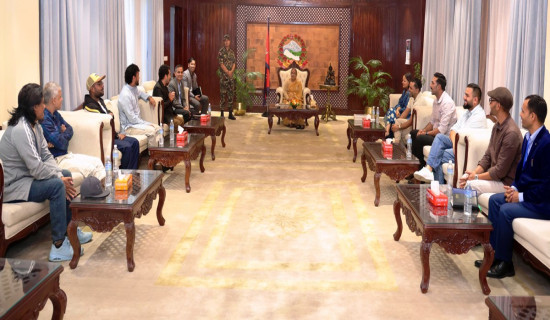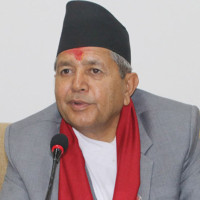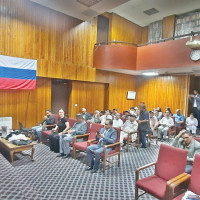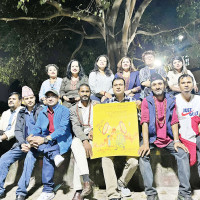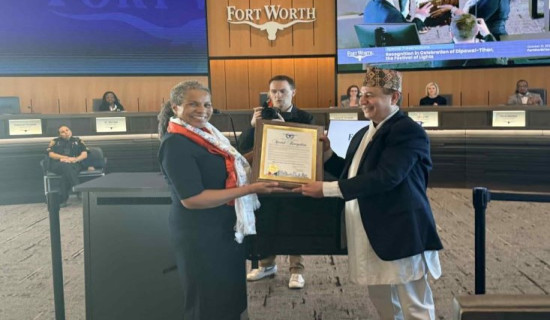- Thursday, 23 October 2025
Ghazal singer Pela makes musical wave
By Renuka Dhakal,Kathmandu, Jan. 31: ‘Ke Lat Basyo Malai’, a Ghazal sang by Tilak Singh Pela, has been the talk of the town for the past two weeks.
Singer Pela, who has remained unheard for several years, is now at the peak of his popularity because of his hit Ghazal.
Penned by Dr. Pradip Mainali, the Ghazal was released two weeks ago in Pela’s official YouTube channel.
A video of the Ghazal shot using a mobile phone of a disciple of singer Pela has succeeded to create waves in the Nepali music.
Audience are blown-away with the exquisite creation of Mainali and soulful voice of Pela.
Constantly active in the classical music for three decades, Pela was steeped in musical practice deeper than the limelight.
A mellifluous voice, soulful music and heartwarming creation have made the song transcendence into the heart and mind of the audience, Pela recently told The Rising Nepal.
Pela, a genuine musician, has chosen the best songs and put his heart into the music and sung euphoniously.
The Ghazal ‘Ke Lat Basyo Malai’ not only put Pela in the spotlight but also changed the perception of common music pattern in style.
It has also clarified the stereotype that a music video should be made to make a song popular.
Pela was fascinated by music since childhood. He used to observe ‘Ramlila’ organised in Baitadi, his home district, with great ardour where true classical music used to be performed.
Although ‘Deuda’ is popular in Sudurpashchim, he became infatuated to classical music through ‘Ramlila’, he said.
Reminiscing about his past, he said that since his childhood, he used to listen to the songs of Mohammed Rafi and Lata Mangeshkar and used to create his own tunes while listening to their songs.
Regarding the tune, he said, “It comes naturally, and instruments and rhythms require constant practice. Even now I compose my own tunes and try to combine natural tunes with musical instruments to compose music for a song.”
His first song was ‘Kahani Banena Mero Kehi Yestai Bhayo Jindagi Mero’ which he recorded from Music Nepal. Then, he released ‘Aansu’ album in 1996 which became popular then.
The album recorded in 1996 was also the first modern song album recorded by a musician from Sudurpashchim, he claimed.
The album became a hit and people started recognising him but he felt that he lacked true musical expertise, so he went in search of a guru to learn music.
He wandered in Kathmandu for a few years in search of a true classical guru. Then he found his guru in Pandit Dhan Bahadur Gopali. After studying music with Gopali for 10 years, he went to Varanasi, India, and studied classical music for another 10 years with Pandit Devashish Dey.
People generally believe that singers are the ones who bring songs to the market, but Pela said that a person who has a complete knowledge of music and can sing well is a true singer.
Stating that it is not necessary that a singer should release songs continuously, he said that according to the definition of classical music, a true singer is one who has full consciousness in music and can sing meticulously.
He also brought ‘Aansu’ part -2 in 1999 and he brought the part three of the same album ‘Nirjan Kinar’ in 2020.
He released around 40 songs so far.
Ghazal composer Mainali had heard Pela's voice on Facebook for the first time and was instantly mesmerised as soon as she heard his voice.
Then Mainali met Pela and the former recited some of his Ghazals from his diary. Coincidentally, both liked ‘Ke Lat Basyo Malai’ Ghazal.
Mainali then requested Pela to record the Ghazal in his voice. At first, Pela wanted to record this Ghazal in his student’s voice, but after Mainali insisted, Pela agreed to record the Ghazal in his own voice.
Stating that classical music is the root of all kinds of music, Pela said that the new generation who wants to become a classical singer should learn music for at least 10 years and practice for at least five years to become a true singer.
Learning classical music requires continuous and long practice. If a person who has learned classical music enters the singing field, the entire music industry will flourish.
Pela practices music for about eight hours every day.
He said, “I am busy teaching music for eight hours a day and I am also practicing music simultaneously.”
“Music is my daily Karma; I do nothing other than music. I am not immersed into music for the purpose of earning a fortune, but for my own satisfaction,” said Pela.
He said that the government has not provided enough support for the music sector. There are some organisations working for the music sector, but they are not led by musicians.
“We are trying our best to promote classical music, but the government has not shown any interest in promoting classical music,” he added.
Regarding lyrics, he said that the role of words is decisive in making a good song. A great song helps to create a great melody and a combination of words, melody and melodious vocal produces an exceptional song, he added.
Pela said that Nepali music has not been internationalised because of lack of good singers in Nepal.
For the all-round development of the Nepali music sector, musicians need to pay attention to quality, not quantity.
Pela has been teaching music continuously since 2004.
“I teach music to around 1,000 students in a year, but I couldn’t guarantee all of them become singers or musicians.”
He said that true musician never succumbs to the lure of popularity.
“Nowadays, there is more propaganda than ‘sadhana’ in music, today's musicians are more focused on how to buy and sell awards or go on foreign tours, but this cheap popularity will not last long,” he argued.



